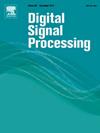Real-time multi-IRS partitioning for sum-rate optimization in a UAV-IRS-aided vehicular communication system
IF 2.9
3区 工程技术
Q2 ENGINEERING, ELECTRICAL & ELECTRONIC
引用次数: 0
Abstract
The rise of autonomous vehicles and intelligent transportation systems demands robust Vehicle-to-Everything (V2X) communication. However, the dynamic and unpredictable nature of vehicular environments, characterized by high mobility and complex signal propagation, presents significant challenges for reliable V2X operation. This paper addresses these challenges by proposing a novel communication model for dynamic vehicular networks that leverages multiple Unmanned Aerial Vehicles (UAVs) equipped with Intelligent Reflecting Surfaces (IRSs). The proposed framework optimizes reflections and trajectories to enhance signal quality and throughput in multi-vehicle environments. To overcome challenges in large-scale IRSs deployments, we introduce a two-step real-time multi-IRSs partitioning algorithm (RTMIP). We formulate an optimization problem to maximize the time-averaged sum-rate by jointly optimizing IRS reflection phases, IRS partitioning scheduling variables, and UAV trajectories, and design an alternating optimization algorithm to solve this problem. Simulation results demonstrate that the proposed algorithm significantly outperforms benchmark strategies in maximizing the time-averaged sum-rate in vehicular communications.
求助全文
约1分钟内获得全文
求助全文
来源期刊

Digital Signal Processing
工程技术-工程:电子与电气
CiteScore
5.30
自引率
17.20%
发文量
435
审稿时长
66 days
期刊介绍:
Digital Signal Processing: A Review Journal is one of the oldest and most established journals in the field of signal processing yet it aims to be the most innovative. The Journal invites top quality research articles at the frontiers of research in all aspects of signal processing. Our objective is to provide a platform for the publication of ground-breaking research in signal processing with both academic and industrial appeal.
The journal has a special emphasis on statistical signal processing methodology such as Bayesian signal processing, and encourages articles on emerging applications of signal processing such as:
• big data• machine learning• internet of things• information security• systems biology and computational biology,• financial time series analysis,• autonomous vehicles,• quantum computing,• neuromorphic engineering,• human-computer interaction and intelligent user interfaces,• environmental signal processing,• geophysical signal processing including seismic signal processing,• chemioinformatics and bioinformatics,• audio, visual and performance arts,• disaster management and prevention,• renewable energy,
 求助内容:
求助内容: 应助结果提醒方式:
应助结果提醒方式:


